How Are Silver Coins Minted?
Most people don’t understand the amount of labor it takes to create a single silver coin, round or bar. This knowledge often goes hand-in-hand with why people don’t understand that they can’t buy a silver or gold coin for the spot price without any premiums. In this article we are going to discuss how a silver round is minted. Silver Coins (i.e.: coins that are produced by the government) are minted with more precision, and with more powerful presses. Something that a private mint can replicate, but requires much greater startup costs. Because they can get the job done with lesser equipment, they do. In this article we are going to discuss how silver rounds are minted.
1. .999 Fine Silver Is Melted Into Billets
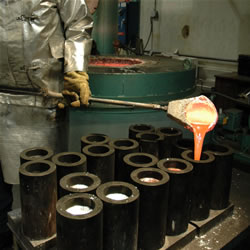 The first step is that .999 fine silver (that has already been refined) is melted at 2000 degrees fahrenheit. At this temperature, the silver becomes molten and pourable. The temperature of the molten silver is key as an undesirable temperature (too hot or too cold) will result in an uneven pour. The molten silver is poured into round billets and allowed to cool into a firm, but pliable state. Once the billets have cooled down they are removed and taken to the extruder.
The first step is that .999 fine silver (that has already been refined) is melted at 2000 degrees fahrenheit. At this temperature, the silver becomes molten and pourable. The temperature of the molten silver is key as an undesirable temperature (too hot or too cold) will result in an uneven pour. The molten silver is poured into round billets and allowed to cool into a firm, but pliable state. Once the billets have cooled down they are removed and taken to the extruder.
2. Silver Billets Are Extruded Into Flat Strips
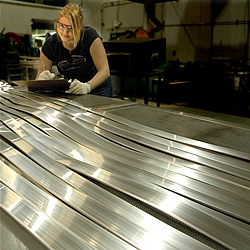 The cooled silver billets (roughly 800 ounces each) are loaded into a heater to warm the billets up so that they are pliable. The warmed billets are then loaded into the extruder and that machine forces the billet with great pressure through a smaller opening. Much in the way a children’s Play-doh machine would make spaghetti by forcing the Play-doh through a small opening, the extruder works in similar fashion but with much greater force.
The cooled silver billets (roughly 800 ounces each) are loaded into a heater to warm the billets up so that they are pliable. The warmed billets are then loaded into the extruder and that machine forces the billet with great pressure through a smaller opening. Much in the way a children’s Play-doh machine would make spaghetti by forcing the Play-doh through a small opening, the extruder works in similar fashion but with much greater force.
Since so much pressure has been applied, the result is a long flat piece of pliable silver. It almost resembles saltwater taffy. This flat piece of silver, dozens of feet long is a specific thickness and is allowed to cool.
3. Flat Strips Are Cut Into Silver Blanks
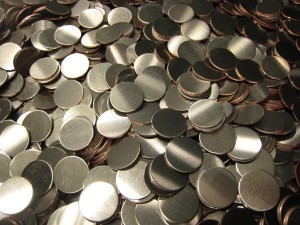 The long flat strips of silver are then fed into a blank punch machine. The machine is armed with a punch set to the proper diameter (39mm). As the flat strips of silver are fed in, the machine just punches out round silver blanks one at a time. The remaining strips that has its holes punched out is then returned to be melted and reused in step 1.
The long flat strips of silver are then fed into a blank punch machine. The machine is armed with a punch set to the proper diameter (39mm). As the flat strips of silver are fed in, the machine just punches out round silver blanks one at a time. The remaining strips that has its holes punched out is then returned to be melted and reused in step 1.
4. Silver Blanks Measured For Proper Weight
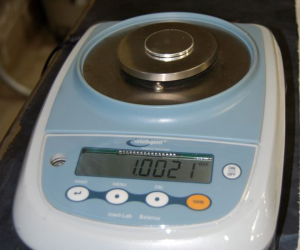 The silver blanks are measured for the proper tolerances. In this case the silver rounds are cut to be 1 troy ounce of silver. The tolerance per 10 coins is three hundredths. This means that per 10 ounces, the weight can be as high as 10.003 ounces. The weight has to be a minimum of 10.000 ounces – they will not accept anything under.
The silver blanks are measured for the proper tolerances. In this case the silver rounds are cut to be 1 troy ounce of silver. The tolerance per 10 coins is three hundredths. This means that per 10 ounces, the weight can be as high as 10.003 ounces. The weight has to be a minimum of 10.000 ounces – they will not accept anything under.
5. Silver Blanks Are Then Burnished (Polished)
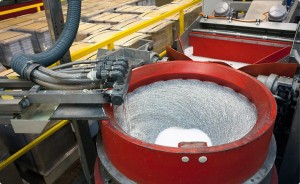 The silver blanks are then loaded into a large, spinning drum that contains thousands of small polishing media – tiny 6mm round balls (satellites) that remove any burrs on the blanks and leave a nice, polished finish.
The silver blanks are then loaded into a large, spinning drum that contains thousands of small polishing media – tiny 6mm round balls (satellites) that remove any burrs on the blanks and leave a nice, polished finish.
6. Polished Blanks Are Stamped With A Die
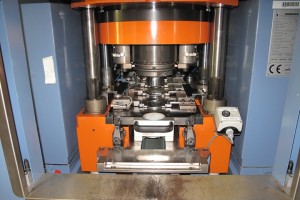 The polished silver blanks are then loaded into a die stamper which presses the design onto the blank. The stamper contains a die with the desired design. Then, under heavy pressure, the die is pressed into the silver blank to create the final silver round.
The polished silver blanks are then loaded into a die stamper which presses the design onto the blank. The stamper contains a die with the desired design. Then, under heavy pressure, the die is pressed into the silver blank to create the final silver round.







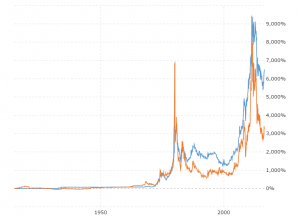

What an interesting video, the care that goes into every coin in unbelievable. Well done.